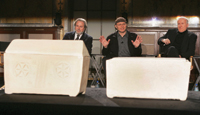by Paul L. Maier
 The March 4th Discovery Channel documentary “The Lost Tomb of Jesus” claimed that the 10 ossuaries discovered at Talpiot in south Jerusalem probably included the bones of Jesus, His mother, His wife, His son, and other relatives. While the documentary was skillfully filmed, its sensational conclusions only continue the long-running media attack on the historical Jesus. It may as well have been called “More Junk on Jesus,” and just in time for the church’s celebration of His resurrection.
The March 4th Discovery Channel documentary “The Lost Tomb of Jesus” claimed that the 10 ossuaries discovered at Talpiot in south Jerusalem probably included the bones of Jesus, His mother, His wife, His son, and other relatives. While the documentary was skillfully filmed, its sensational conclusions only continue the long-running media attack on the historical Jesus. It may as well have been called “More Junk on Jesus,” and just in time for the church’s celebration of His resurrection.
Nearly every interested archaeologist or historian in the world has found the documentary’s conclusions unfounded. Here are the most important reasons:
1. Nothing is new here: Scholars have known about the ossuaries since 1980. The general public learned of them with a 1996 BBC documentary. But now James Cameron (director of the movie Titanic) and Canadian director Simcha Jacobovici have climbed aboard the sensationalist bandwagon.
2. All the names, Yeshua (Joshua, Jesus) son of Joseph, Jose (Joseph), Maria (Mary), Mariamene e Mara, Matia, and Judah son of Jesus, are extremely common Jewish names for that time and place. One out of four Jewish women at that time, for example, was named Mary. There are 21Yeshuas (Jesuses) cited by Josephus, the first-century Jewish historian, who were important enough to be recorded by him, with many thousands of others that never made history. Nearly all scholars consider that these names are merely coincidental. Some even dispute that “Yeshua” is one of the names.
3. The mathematical odds hyped by Jacobovici that these names must refer to Jesus and His family are simply playing with numbers. To reach his conclusions, one must believe every link in the long chain of hypotheses he presents. In fact, every link is weak enough to break the chain.
4. There is no reason whatever to equate “Mariamene e Mara” with Mary Magdalene. In fact, a better translation is “Mary, also called Mara.” And so what if her DNA is different from that of “Yeshua” ? That particular “Mariamene” could indeed have been the wife of that particular “Yeshua.”
5. Why in the world would the “Jesus family” have a burial site in Jerusalem, of all places, the very city that crucified Jesus? Galilee was their home, not Judea.
6. Church tradition and the earliest Christian historian, Eusebius of Caesarea, unanimously report that Mary, the mother of Jesus, died in Ephesus (in modern Turkey), where the apostle John, faithful to his commission from Jesus on the cross, had accompanied her.
7. The “Jesus family” could not have afforded the large, ornate crypt at Talpiot. This is the burial site of a prominent, upper middle-class or wealthy family from Jerusalem, not a carpenter’s clan from Galilee.
8. If this were Jesus’ family burial site, what is Matthew doing there, if indeed “Matia” is thus to be translated?
9. There is no tradition whatever, Christian, Jewish, or secular, that any of the Holy Family was buried at a family plot in Jerusalem.
10. Note the extreme bias of Simcha Jacobovici, apparently an Indiana-Jones-wannabe who seems to sensationalize anything he touches. As for James Cameron, how do you follow the success of Titanic? Well, with an even more “titanic” story. The dramatic recreations in their documentary favoring their hypotheses, the statements of experts taken out of context, the misquotations of some of those experts, and their selective editing are all a disservice to the truth.
11. Even Israeli archaeologists and authorities, who, were they anti-Christian, might have used this “discovery” to discredit Christianity, did not do so. Quite the opposite. Joe Zias, for years the director of the Rockefeller Museum in Jerusalem, said those involved in the project “have no credibility whatever.”
Amos Kloner, the first archaeologist to examine the site, said Jacobovici’s conclusions are “completely impossible … nonsense.” In a Jerusalem Post interview, he added, “Three or four ossuaries have been discovered with the names, ‘Jesus, son of Joseph.'”
David Mevorah, curator of the Israel Museum, calls the claims “far-fetched.”
William Dever, one of America’s prominent archaeologists, said, “This would be amusing if it didn’t mislead so many people.”
12. Most important, all four Gospels; the Book of Acts; the letters of Paul, Peter, and other apostles; as well as the common testimony of the early church state that Jesus rose from the dead and did not leave His bones behind in any ossuary.





